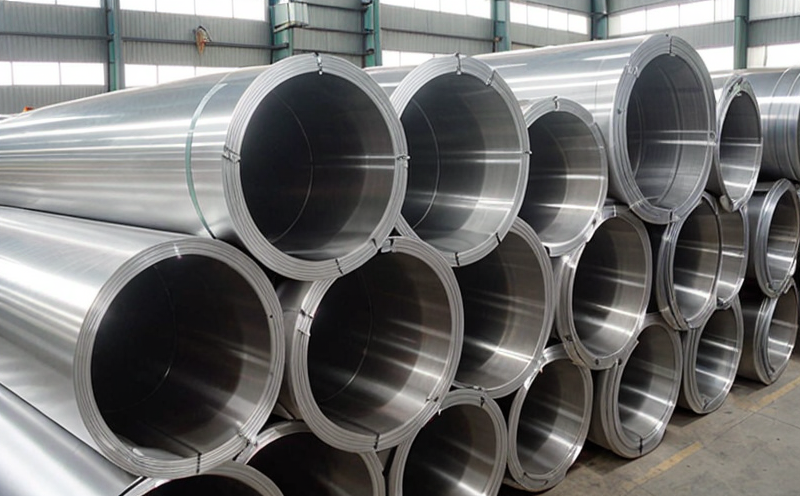ASTM D5229 Moisture Absorption Testing of Marine Composites
The ASTM D5229 standard is a critical procedure used in the testing of moisture absorption properties specifically for marine composite materials. These materials are widely utilized in the construction of boats, yachts, and other maritime equipment due to their lightweight, corrosion-resistant, and durable characteristics.
Made from a combination of fibrous reinforcement (such as carbon or glass fibers) embedded in an epoxy resin matrix, these composites play a significant role in marine applications. The integrity and longevity of the materials are paramount for ensuring safety at sea. ASTM D5229 provides a standardized method to determine the rate at which moisture is absorbed into these composite structures under controlled conditions.
The testing process involves placing samples of the composite material in water and measuring their weight gain over time. This measurement helps quantify the moisture absorption capability, which can impact the overall performance and reliability of the marine equipment. Understanding this property is essential for quality managers, compliance officers, R&D engineers, and procurement personnel responsible for selecting materials that meet stringent industry standards.
Accurate testing ensures that manufacturers comply with international maritime regulations and guidelines, thereby enhancing safety and operational efficiency on the seas. The methodology described in ASTM D5229 is widely recognized and accepted by major marine equipment manufacturers, regulatory bodies, and testing laboratories around the world.
The standardized procedure provides a consistent approach to moisture absorption testing, which ensures that results are comparable across different labs and regions. This consistency is crucial for quality assurance and compliance with international standards such as ISO 17805 (for general purpose thermoplastics) and ASTM D6272-13 (for determining the tensile properties of plastics).
The testing process typically involves several key steps:
- Sample preparation: Specimens are cut to standard dimensions and sizes.
- Conditioning: Samples undergo conditioning prior to immersion in water to ensure they reach equilibrium moisture content.
- Immersion: The samples are placed in a controlled environment where the rate of absorption can be measured accurately.
- Weighing: Samples are weighed before and after the specified time period to calculate weight gain due to moisture absorption.
The results of ASTM D5229 testing provide valuable insights into the performance characteristics of marine composite materials, enabling informed decisions in material selection and design optimization. This information is particularly useful for R&D engineers who are tasked with developing new composite formulations that balance strength, weight, and moisture resistance.
Scope and Methodology
The ASTM D5229 standard specifies the procedure for determining the rate of moisture absorption in marine composite materials by immersion. The primary scope of this test is to evaluate how quickly water penetrates the material, which can affect its durability and integrity over time.
| Test Parameters | Specimen Requirements | Testing Environment | Measurement Criteria |
|---|---|---|---|
| Temperature and Humidity Control | Standardized specimen dimensions | Controlled water bath | Weight gain before and after immersion |
| Water Type | Conditioning period | Duration of immersion | Percentage increase in weight |
The testing process begins with the preparation of standardized specimens, which are conditioned to reach equilibrium moisture content. The specimens are then immersed in a controlled water bath for a specified duration. Afterward, their weights are measured and compared to initial readings to determine the rate of moisture absorption.
This standardized procedure ensures that all tests conducted follow uniform protocols, thereby facilitating accurate comparisons between different materials or manufacturers. Compliance with ASTM D5229 is essential for ensuring product quality, safety, and regulatory adherence in the marine industry.
International Acceptance and Recognition
- The ASTM D5229 standard has been adopted by several international organizations and standards bodies.
- It is recognized by major maritime equipment manufacturers worldwide.
- Compliance with this standard ensures that products meet stringent industry requirements.
- Absorption testing results are accepted in various countries, including the United States, Europe, and Asia.
The wide acceptance of ASTM D5229 in the global market underscores its importance in ensuring consistent and reliable moisture absorption properties across different regions. This standard is particularly significant for companies operating internationally or those seeking to export their products.
Compliance with ASTM D5229 not only enhances a company's reputation but also opens doors to new markets by demonstrating adherence to international best practices. Regulatory bodies in various countries often require compliance with this standard as part of the certification process, making it essential for manufacturers and suppliers in the marine industry.
The consistent application of ASTM D5229 across different laboratories ensures that results are comparable and reliable, which is crucial for quality control and product safety.
Use Cases and Application Examples
ASTM D5229 moisture absorption testing plays a vital role in the development and quality assurance of marine composite materials. Here are some real-world applications:
| Application | Description |
|---|---|
| Buoy Design | Evaluating how buoyancy is affected by moisture absorption. |
| Boat Hull Construction | Ensuring the hull remains watertight and structurally sound. |
| Towing Equipment | Testing for durability under prolonged exposure to seawater. |
| Fishing Vessels | Evaluating the impact of moisture absorption on fishing gear performance. |
| Yacht Construction | Ensuring that the yacht remains afloat and structurally sound during long voyages. |
| Pontoons and Decks | Evaluating durability in freshwater environments. |
| Floating Platforms | Testing for resistance to environmental factors such as saltwater and UV radiation. |
In each of these applications, ASTM D5229 testing is crucial for ensuring that the marine composite materials used are capable of maintaining their integrity and performance under harsh conditions. By accurately quantifying moisture absorption rates, manufacturers can make informed decisions about material selection and design optimization.





